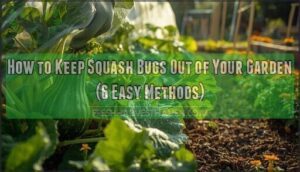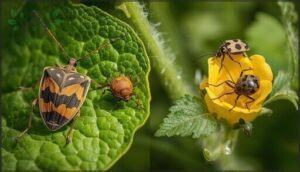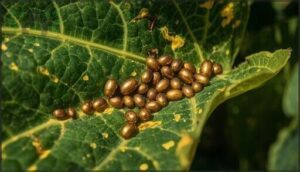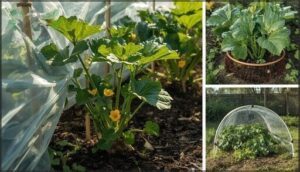This site is supported by our readers. We may earn a commission, at no cost to you, if you purchase through links.

The good news? Keeping squash bugs out of your garden is far easier than evicting them after they’ve moved in. A few strategic moves in early spring—like clearing last year’s debris, installing simple barriers, and choosing the right varieties—can slash your squash bug population by more than half before the growing season even begins.
Table Of Contents
- Key Takeaways
- Identifying Squash Bugs in Your Garden
- Preventing Squash Bugs From Overwintering
- Using Physical Barriers to Deter Squash Bugs
- Practicing Crop Rotation and Resistant Varieties
- Organic and Manual Squash Bug Control Methods
- Attracting Beneficial Insects and Companion Planting
- Frequently Asked Questions (FAQs)
- Conclusion
Key Takeaways
- Clearing out old plant debris, weeds, and mulch in fall eliminates the hiding spots where squash bugs overwinter, cutting next season’s population by up to 80% before they even hatch.
- Installing lightweight row covers immediately after transplanting creates a physical barrier that blocks squash bugs completely, but you’ll need to remove them when flowers appear so bees can pollinate your plants.
- Choosing naturally resistant varieties like Butternut, Royal Acorn, or Green Striped Cushaw reduces squash bug damage by 45–60% compared to vulnerable types, giving you a built-in defense from day one.
- Hand-picking bugs and scraping off their bronze egg clusters every few days delivers 87% removal when done consistently, especially when you drop collected pests into soapy water to finish them off.
Identifying Squash Bugs in Your Garden
Before you can protect your garden, you need to know what you’re up against. Squash bugs have a distinct look that sets them apart from other garden pests, but they’re often confused with similar insects.
Let’s walk through how to identify adults, nymphs, eggs, and the telltale signs of damage they leave behind.
Recognizing Squash Bug Adults and Nymphs
Adult squash bugs are flat-backed, dark gray to brown insects about 5/8 inch long with orange stripes along their abdomen edges.
Squash bug nymphs change as they grow:
- First instar – Light green with red or black legs
- Early stages – Green abdomen with black head
- Later instars – Gray or brownish-gray coloration
- Fifth instar – Powdery gray with developing wing pads
- Behavioral traits – Both hide under leaves when disturbed
To manage them effectively, early detection through crop monitoring is essential.
Differentiating Squash Bugs From Similar Pests
Identifying squash bugs correctly saves you time and effort. Stink bugs are rounder and lack the orange abdominal stripes squash bugs display. Assassin bugs have longer legs and a narrow neck region. Cucumber beetles cause bacterial wilt instead of the sap-feeding damage squash bugs create.
Check for flat, shield-shaped bodies with alternating light and dark stripes—that’s your squash bug. Knowing how to identify squash bug nymphs is key for early intervention.
Morphological differences and feeding damage patterns matter when scouting garden pests.
Spotting Squash Bug Eggs and Damage
Once you spot the bugs, look for their egg masses on the undersides of leaves. Squash bug eggs appear as shiny bronze or reddish-brown clusters arranged between leaf veins. You’ll find:
- 15 to 25 eggs per cluster
- V or triangular patterns along veins
- 87% of egg clusters underneath leaves
- Darker eggs ready to hatch within 7–10 days
Yellow puncture marks and wilting signal feeding damage signs requiring immediate action.
Preventing Squash Bugs From Overwintering
The best time to stop squash bugs is before they even show up in spring. These pests hunker down in your garden over winter, hiding in old plant material and debris until warm weather returns.
Here’s how to eliminate their hiding spots and cut next year’s infestation before it starts.
Removing Old Plant Debris and Garden Refuse
Dead leaves and old vines are like cozy hotels for squash bugs waiting out winter. When you clear away garden debris each fall, you can slash next year’s bug population by up to 80%. Don’t just toss leaf litter on your compost pile—burn or bag heavily infested dead plants to break disease cycles and protect soil health.
Clearing garden debris each fall can slash next year’s squash bug population by up to 80 percent
| Debris Type | Squash Bug Risk | Best Disposal Method |
|---|---|---|
| Infected vines | Very high | Burn or trash |
| Leaf litter | High | Hot compost only |
| Old fruit | Moderate | Remove promptly |
Garden cleanup isn’t just tidying—it’s your strongest pest management move. You’re eliminating overwintering habitats while disrupting disease cycles that harm future crops.
Fall Tillage and Soil Disturbance
Right after your fall garden cleanup, tilling disturbs the top six inches of soil where squash bug adults and their eggs hide. Early fall tillage timing—ideally right after harvest—reduces overwintering survival by up to 60%.
Just be mindful: excessive soil disturbance can disrupt beneficial arthropods that help control pests naturally. Balance is key for both pest control and yield impact.
Cleaning Up Weeds and Mulch Near Cucurbits
Weeds and thick mulch layers give squash bugs cozy spots to hide and survive winter. Weed removal alone can cut adult survival by up to 80%, while pulling back mulch from plant bases drops overwintering bugs by 70%.
Keep your garden clean—clear dead leaves, leaf litter, and garden debris within a few feet of cucurbits. Sanitation practices and perimeter management matter more than you’d think for weed control.
Using Physical Barriers to Deter Squash Bugs
One of the smartest ways to stop squash bugs is to keep them away from your plants in the first place. Physical barriers create a shield between your vulnerable seedlings and those hungry pests looking for a place to feast and lay eggs.
Let’s look at three simple barrier methods that don’t require any chemicals or complicated setups.
Installing Row Covers on Young Plants
Row covers create a fortress around your cucurbits, preventing squash bugs from landing on young plants. Install lightweight floating row covers—like Agribon-19—right after transplanting, before any pests appear.
Drape the material over hoops spaced every four feet, then anchor the edges with rocks or boards. This installation timing and anchoring technique stops squash bugs cold while maintaining proper venting strategies underneath for healthy plant growth.
Timing Row Cover Removal for Pollination
You can’t leave row covers on forever—squash needs pollination to produce fruit. Remove covers when flowers appear, usually around 30–35 days after planting, to allow bee activity. This critical pollination window lasts about 7–10 days.
Here’s what to watch for:
- Heat buildup: Temperatures under covers can spike 10–15°C, damaging flowers
- Timing matters: Late removal reduces yields by 40% on average
- Pest recolonization: Squash bugs return within 48 hours, so monitor closely
If you’re worried about pest recolonization, try hand pollination under closed covers or open them daily for 1.5–4 hours during morning bloom.
Setting Traps With Boards or Tape
Traps turn the bugs’ own behavior against them. Lay plywood boards (0.91 x 0.61 meters) near squash plants—bugs hide underneath at night. Check every morning and crush what you find. For eggs, press duct tape directly onto clusters under leaves; it removes nearly 100% without harming foliage. Board trap placement within 60 cm of plants boosts capture by 25%. Tape egg removal stops nymphs before they hatch, cutting populations by 42% in four weeks.
| Trap Method | Best Target |
|---|---|
| Board traps | Adults and older nymphs |
| Tape removal | Eggs and new nymphs |
| Combined approach | Maximum pest control |
These garden pest control methods work best in small gardens. Check traps at sunrise—78% of bugs escape if you wait past two hours. Tape egg removal takes 9–14 minutes per plant during peak season, but this pest management effort pays off. Neither method alone hits the threshold of one bug per plant in heavy infestations, so combine them with crop rotation and resistant varieties for reliable garden pest control.
Practicing Crop Rotation and Resistant Varieties
Once squash bugs find a home in your garden, they’ll keep coming back year after year if you let them. The good news is that you can break this cycle by changing where you plant and choosing varieties that naturally resist these pests.
Let’s look at three simple strategies that make your garden a less inviting place for squash bugs to settle.
Rotating Squash and Cucurbit Plantings
Crop rotation techniques work by moving your cucurbits at least 25 feet away from last year’s patch—this simple shift cuts squash bug numbers by nearly a third. Timing optimization matters: rotate after peak migration in late May to early June.
The catch? Pest mobility means bugs can fly nearly a mile, so pair crop rotation strategies with cultural integration like debris cleanup and row covers for real control.
Choosing Squash Bug-Resistant Plant Varieties
Beyond moving your garden beds, you can choose resistant cultivars to stack the deck against squash bugs. Butternut, Royal Acorn, and Green Striped Cushaw show the strongest variety resistance levels—field studies found they reduce squash bug damage by 45–60% compared to susceptible types.
Regional performance data confirms these plant varieties consistently lower pest numbers, giving you a real head start in cucurbits protection.
Spacing Plants to Reduce Pest Habitat
After picking resistant varieties, you can boost your pest prevention through strategic spacing. Give your garden plants 3–4 feet between summer squash and 6–8 feet between rows—this creates ideal airflow that drops pest microclimate humidity and discourages bug colonization.
That spatial arrangement, paired with crop rotation and companion planting near cucurbits, produces cultural integration that cuts squash bug densities by up to 35%.
Organic and Manual Squash Bug Control Methods
When squash bugs show up despite your best prevention efforts, you’ll need hands-on tactics to manage them. The good news is you don’t have to reach for harsh chemicals—there are several organic methods that work remarkably well when used consistently.
Here are three proven approaches you can start using today to take back control of your squash patch.
Hand-Picking Bugs and Scraping Eggs
Checking your plants every few days lets you catch squash bugs and their eggs before they multiply. Regular handpicking delivers up to 87% removal efficacy when you stay on top of it. Here are your best practices for plant health:
- Inspect leaf undersides where squash bug eggs cluster in groups of 12–20
- Scrape off eggs with your fingernail or a butter knife
- Drop adults and nymphs into a container
Despite strong control benefits, egg scraping presents challenges in dense foliage.
Using Soapy Water for Bug Removal
Once you’ve collected squash bugs by handpicking, drop them into soapy water to finish the job. A simple 2% solution—about two tablespoons of dish soap per quart of water—kills them in seconds by clogging their breathing pores.
You can also spray this mixture directly on adults and nymphs for 82% mortality, though it won’t harm eggs.
Applying Neem Oil or Diatomaceous Earth
Neem oil disrupts squash bug feeding and reproduction, cutting egg-laying by 75%. Mix 1–2 tablespoons per gallon and spray weekly for organic squash bug control.
Diatomaceous earth offers eco-friendly pest control through desiccation—dust it around plant bases for 80% effectiveness when dry.
Integrated use of both methods controls squash bugs best: neem oil stops eggs while DE targets nymphs, maintaining safety impact for your garden.
Attracting Beneficial Insects and Companion Planting
Nature has its own defense team ready to help you tackle squash bugs. By inviting the right insects into your garden and choosing plants that pests naturally avoid, you can build a living shield around your crops.
Here are three ways to let beneficial bugs and companion plants do the heavy lifting for you.
Encouraging Natural Predators Like Tachinid Flies
Think of tachinid flies as your garden’s secret weapon against squash bugs—these natural predators can parasitize up to 80% of adults when conditions are right. You’ll boost parasitism rates and support the fly lifecycle through habitat enhancement and insecticide avoidance.
Here’s how attracting beneficial insects works:
- Plant Queen Anne’s lace, dill, fennel, or parsley for nectar
- Maintain diverse floral resources throughout summer
- Avoid broad-spectrum pesticides that harm flies
- Keep flowering plants near your squash patch
This organic pest control method works best with encouraging natural predators season-long.
Planting Companion Herbs to Repel Squash Bugs
By planting marigolds, nasturtiums, or calendula alongside your squash, you’ll use companion planting strategies that create measurable outcomes—feverfew cut squash bugs by 48%, while radishes dropped egg clusters by 75%.
These pest deterrents work through repellent mechanisms like basil’s citronellal oils and catnip’s nepetalactone. Herb effectiveness varies, but practical application is simple: interplant companion plants in borders or rows for natural protection.
Monitoring and Managing Beneficial Insect Populations
Once natural predators like tachinid flies arrive, you’ll need to track their presence—sampling standards call for 10 randomized checks per planting area to gauge insect biodiversity accurately. Supporting beneficial insects through habitat correlation practices amplifies conservation impacts while enabling ecofriendly pest control:
- Install birdhouses and flowering margins to shelter pollinators
- Monitor weekly using automated tools or visual surveys
- Preserve weedy undergrowth near squash rows
- Avoid broad-spectrum sprays during peak activity
- Document natural predators to adjust future strategies
Frequently Asked Questions (FAQs)
What time of year do squash bugs appear?
Squash bugs emerge when soil temperatures hit 59–68°F, usually April in southern regions and late May through mid-June up north.
Adult emergence kicks off the egg-laying period that follows shortly after.
Can squash bugs survive cold winter temperatures?
Adult squash bugs can survive freezing temperatures by overwintering under plant debris, rocks, and woodpiles. Snow insulation and debris shelter help protect them during bug dormancy, though sustained cold below 32°F increases mortality considerably.
Do squash bugs damage fruit or just leaves?
While squash bugs absolutely devastate leaves and stems with their toxic feeding, they also attack developing fruits—scarring surfaces, creating sunken spots, and opening doors to rot that ruins your harvest quality and market value.
How quickly do squash bug populations grow?
Under warm conditions, squash bug populations explode fast. Egg hatching takes just seven to ten days, nymph development completes in four to six weeks, and adult longevity spans months—giving each female reproductive potential to lay 250 eggs.
Are there chemical sprays effective against squash bugs?
Yes, but with caveats. Chemical options like pyrethrins and dinotefuran show 70–100% insect control in trials.
However, resistance concerns and beneficial impact matter—pesticides harm pollinators and natural enemies.
Application timing and neem oil offer safer alternatives.
Conclusion
Picture your squash vines thriving, unbothered by pests, while your neighbor battles bronze invaders. That’s the payoff for keeping squash bugs out of your garden before they establish themselves.
Start with spring cleanup, add row covers early, and hand-pick any stragglers you spot. These steps aren’t complicated—they’re just consistent.
By focusing on prevention rather than panic, you’ll protect your harvest and enjoy the growing season you actually planned for.











